Matchmaking
Mexico’s leading B2B conference organizer uses a customized app to deliver an unparalleled experience
The MBE App delivered AI-powered intent-based matchmaking to the Mexico Business Summit 2023 attendees
MBE A pp Impact
231 participants
2,256 matchmaking communications
292
1:1 meetings conducted
51 speakers
2nd Edition
Conference social media impact
9,774 direct impressions during MNS
9 sponsors
4,263 visitors to the conference website
Pre-conference social media impact
85,880 direct pre-conference LinkedIn impressions
7.24% click through rate during MNS 3.61% pre-conference click through rate
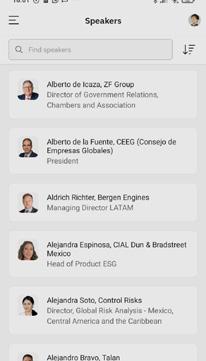
9.6% conference engagement rate 3.19% pre-conference engagement rate Total
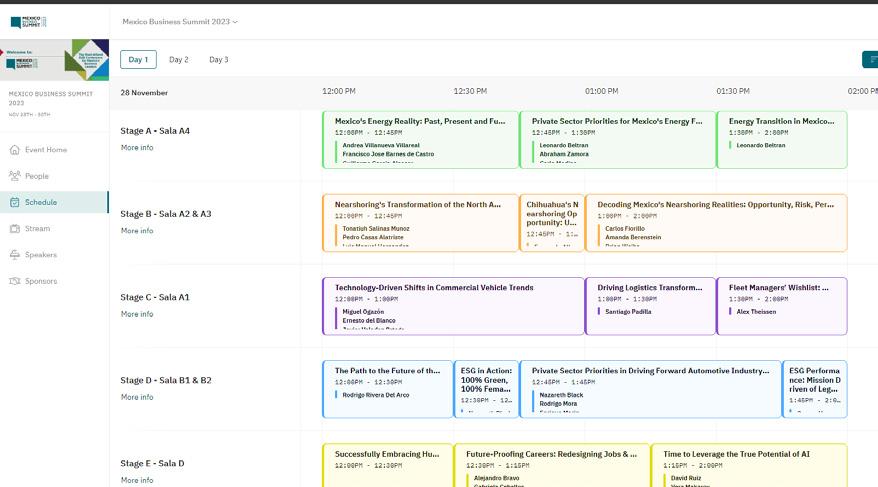

Matchmaking intentions
991
2,575


4
31% CEO / CM / DG 24% Manager / Head of Division 17% Government Affairs Representative / Chamber of Commerce 16% VP / President / Partner 12% Manager / Consultant
Trading 17 Recruitment 41 Investment
Networking 32 Mentoring
1,494
• Achilles Group
• ADELAT
• Aggreko
• Agon
• Albaa Legal Tech
• ALLUX
• AME
• American Society of Mexico
• AMSoC
• Arendal S de RL de CV
• ARMo R-IIMAK México
• Asociación Mexicana de Gas Natural (AMGN)
• Asolmex
• ATCo Energía
• Axis Energy
• Ayuntamiento de toluca
• AZ Industries SA de CV
• BBVA
• Bepensa
• BLUE GLo BAL ENERGy
• BME Shipping
• BoSCH
• British Embassy
• Brose Group
• Burns & McDonell
• Business Director
• Caffécito
• Caliza
• Camara de diputados
• CANACINTRA
• CANACINTRA EDo MEX
• Cancún Cards
• Capwatt
• Carl Zeiss de México, S.A. de C.V.
• CATEM
• Catenon
• Centro de Investigación y Desarrollo CARSo
• CFE
• China Chamber of Commerce and Technology Mexico
• Compusoluciones
• Concamin
• Connecting Mexico by GEP
• Consejo de Empresas Globales en México
• Consultoría G2H
• Continental Automotive
• Co PARMEX CDMX
• Corporativo Enciso
• CyDSA
• Delegación General de Quebec en México
• Doxia
• Edison Energy
• Enel
• Energía Real
• Engie
• ERGoSo LAR
• ESCo
• E y Mexico
• FedEx Express México
• Fibra MT y
• Framecrete Holding Worldwide
• Frontier Industrial by Artha Capital
• Gasoducto de Morelos
• GE Grid Solutions
• GEM
• Generadora Fénix
• Gensler
• Gobierno de Durango
• Gobierno del estado de Coahuila
• Gobierno del Estado de Guanajuato
• Gobierno del Estado de México
• Governor of Aguascalientes
• Grupo Constructor Industrial
• Grupo Imperial
• Grupo IPS
• Grupo JETLoG
• Grupo PEo
• Grupo Valoran
• Hitachi Energy México
• Holcim Mexico
• Holland & Knight
• Holland House Mexico
• Hooman
• HSBC
Co MPAN y A TTENDANCE 5
• Iberdrola
• IBH
• INA
• Infor
• Ingredion Mexico
• International Business Solutions
• J2W
• Kiewit
• LDR Solutions
• Livingston International Mexico
• Logicalis
• Lo NGi
• Luupa AI
• Magna Formex
• Marcos y asociados
• Marketing 4 Sunset Group, S.A. DE c.v.
• MEGAFLUX
• Misumi México
• MRII Capital
• MURGUIA
• Naturgy
• oca Global
• oracle de Mexico
• Paola´s Bakery
• Parks Industrial
• Phoenix Contact
• Picarro
• Pontones y Ledesma
• PRIMA.IA
• Procoahuila
• ProColombia
• Proistmo
• PRo MPERÚ en México
• Proterra Capital
• Protexa
• Quartux Mexico
• Representación del Gobierno del Estado de SLP en CDMX
• Risoul
• Roa
• Satyam Venture Eng Services
• Secretaria Desarrollo Económico
• Sempra Infraestructura
• Sener
• Shacman Trucks
• Sherwin WIlliams
• Siemens
• Sika
• Solfium
• Source Latam FS
• Speakap
• Spencer Stuart
• SSA Mexico
• State Government of Estado de Mexico
• Stragia
• Strategic Projects Manager
• Thomson Reuters
• Toyota Motor Mexico
• TREBoTTI
• Turner & Townsend
• Utilities Director
• Vidialsa
• Vitesco Technologies Mexico
• We Connect International
• Willscot Mexico
• Wood Mackenzie
• Work one Solutions
• WTS Energy
• ZF
Co MPAN y A TTENDANCE 6
09:00
09:15
TIME TO CAPITALIZE ON MEXICO’S NEARSHORING MOMENTUM
Speaker: Marco Antonio del Prete, AMSDE
VITAL VECTORS TO MEXICO’S NEARSHORING COMPETITIVENESS: ENERGY, INFRASTRUCTURE, TALENT
Moderator: Armando Zúñiga, Co PARMEX CDMX
Panelists: Roberto Arechederra, State Government of Jalisco
Ulises Fernández, State Government of Chihuahua
Arturo Ortiz, SEDECo Durango
Enrique Nachón, State Government of Veracruz
11:30 THE ENERGY FACTOR: DECARBONIZING MEXICO’S AUTOMOTIVE INDUSTRY
Moderator: Andrés Friedman, Solfium
Panelists: Ivette Castillo, GE Grid Solutions
Edgardo Perea, Brose Group
Juan Manuel Cerdeira, SEV Mexico
12:15
12:30
BEATING GRID LIMITATIONS TO ENSURE ENERGY SUPPLY SUCCESS
Speaker: Mario Cavazos, Aggreko
INDUSTRY PERSPECTIVES ON ENERGY INFRASTRUCTURE DEVELOPMENT FOR MANUFACTURING GROWTH
Moderator: Rodolfo Rueda, Holland & Knight LLP
Panelists: Gonzalo Azcárraga, SENER
Victor Mejía, Energía Real
Marco Cosío, Siemens
Josefa Casas, Doxia
15:00
THE FUTURE OF NATURAL GAS AND LNG IN MEXICO’S ECONOMY
Moderator: Malvin Delgado, Picarro
Panelists: Ana Ludlow, ENGIE Mexico
Vania Laban, Asociación Mexicana de Gas Natural
Sergio Romero, Sempra Infrastructure
Mauro Juárez, Naturgy Mexico
16:00
UNLEASHING SOLAR POTENTIAL TO GUARANTEE SUSTAINABLE ENERGY SUPPLY
Moderator: Nelson Delgado, ASoLMEX
Panelists: Alessandra Amaral, ADELAT
Ricardo Zúñiga, CapWatt
Iván Reyes, Lo NGi
Jorge Musalem, CFE
16:45
17:00
AME: STRATEGIC VISION 2030
Speaker: Gumersindo Cué, AME
CATEM’S ROLE: TAKING ADVANTAGE OF NEARSHORING IN MEXICO
Speaker: José Carlos Saavedra, CATEM
P R o GRAM D A y 1 7
09:00
THE MEXICO OPPORTUNITY IN THE GLOBALIZATION OF THE CHINESE AUTOMOTIVE AND ENERGY INDUSTRIES
Speaker: Carolina Núnez, China Chamber of Commerce and Technology Mexico
09:15
CHINESE AUTOMOTIVE OEM ACHIEVEMENTS AND AMBITIONS IN MEXICO
Moderator: Carolina Nuñez, China Chamber of Commerce and Technology Mexico
Panelists: Ari Ben Saks, E y
Carlos Pardo, Shacman Trucks
Sergio Chavarría, LDR Solutions
10:00
EXPLORING THE ADVANTAGES OF THE STATE OF MEXICO IN FACE OF NEARSHORING
Speaker: Laura González, State Government of State of Mexico
10:20 THE INTEGRATION OF MEXICAN MANUFACTURING INTO NORTH AMERICAN SUPPLY CHAINS
Speaker: Andrés Díaz, Co NCAMIN
11:30 MEXICO, US AND CHINA: TARIFFS, TALENT, ENERGY, SECURITY AND THE FUTURE OF NEARSHORING INVESTMENT
Moderator: Mauricio Jaramillo, Mexico Texas-European Chamber of Commerce
Panelists: Kenneth Smith, Agon
Larry Rubin, American Society of Mexico
Pablo Gopp, Thomson Reuters
12:30
12:50
SECURITY MODELS AND MORAL CHOICES: THE HUMAN FACTOR
Speaker: Jorge Uribe, Grupo IPS
THE FUTURE OF ELECTROMOBILITY: THE IMPORTANCE OF DEVELOPING ELECTRIC POWERTRAIN
Speaker: Antonio Rodríguez, Vitesco Technologies
13:10
TECHNOLOGICAL TALENT: STRATEGIC FACTOR FOR MEXICO’S FUTURE COMPETITIVENESS
Speaker: David Pineda, Continental
15:00
SUPPLY CHAIN PRIORITIES AT TIMES OF AUTOMOTIVE INDUSTRY TRANSFORMATION
Moderator: Armando Cortés, INA
Panelists: Jorge Luis Torres, FedEx Express México
Emanuel Soto, ZF Group
Alejandro Luna, INFo R
16:00
THE VALUE OF NEARSHORING: OPTIMIZING ELECTRIFIED VEHICLE PRODUCTION FOR AN ELECTRIFIED MEXICO
Speaker: Luis Lozano, Toyota Motor de México
16:30
AGUASCALIENTES: IDEAL DESTINATION FOR NEARSHORING
Speaker: Teresa Jiménez, State Government of Aguascalientes
8 PR o GRAM DA y 2

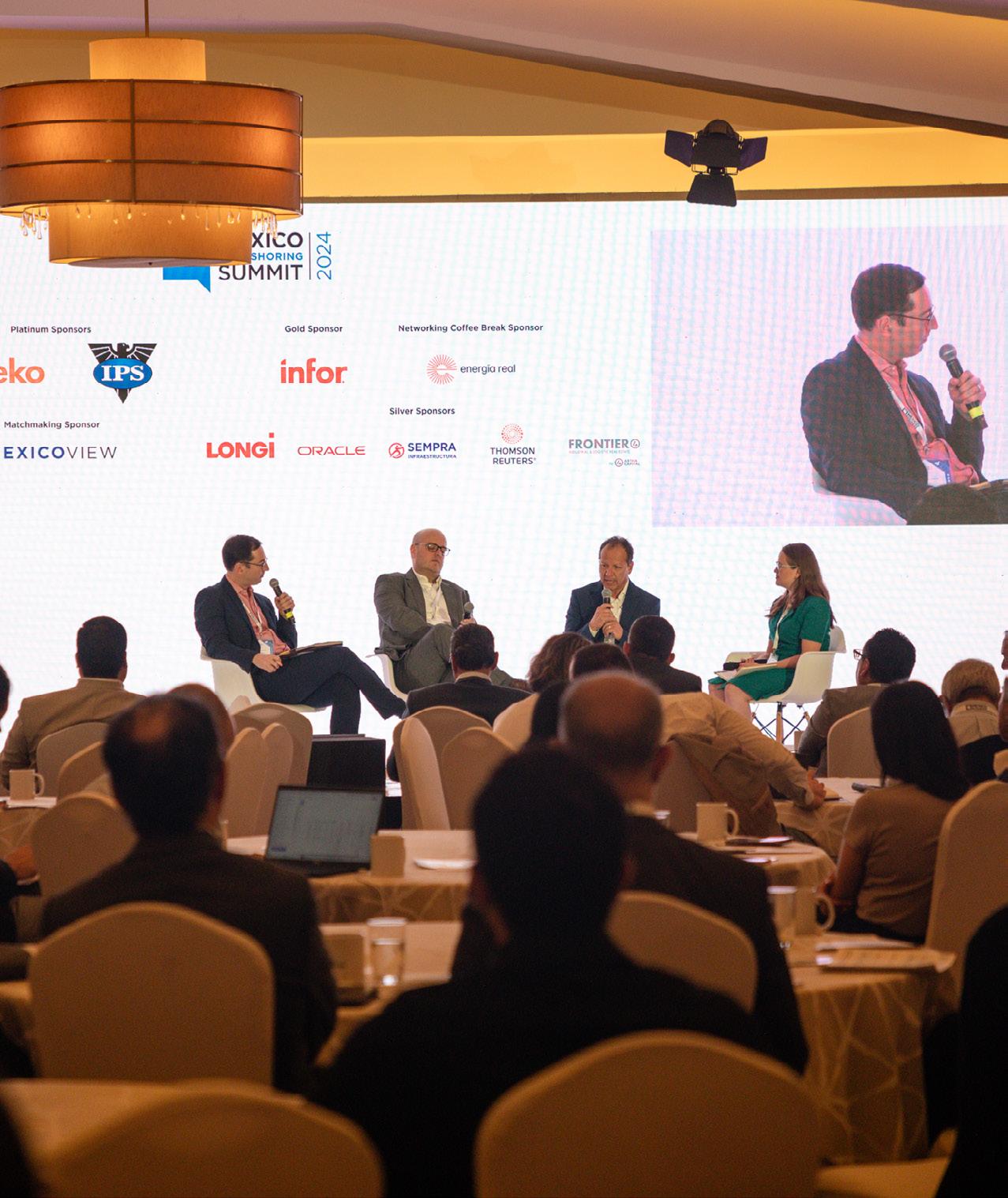
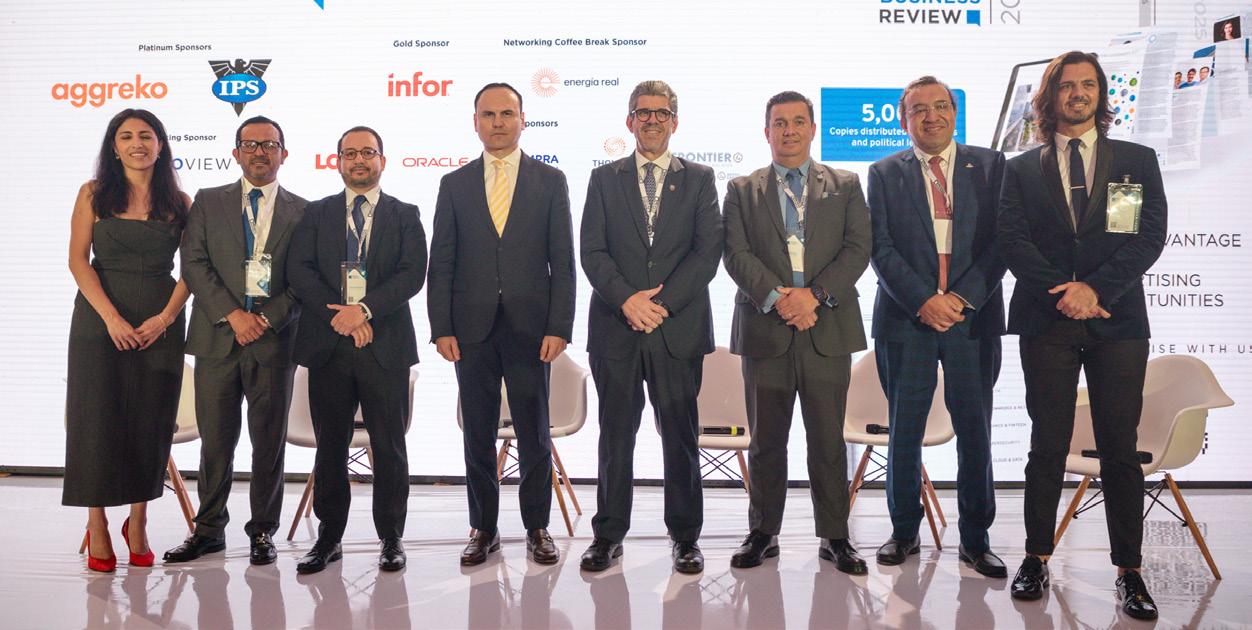



9





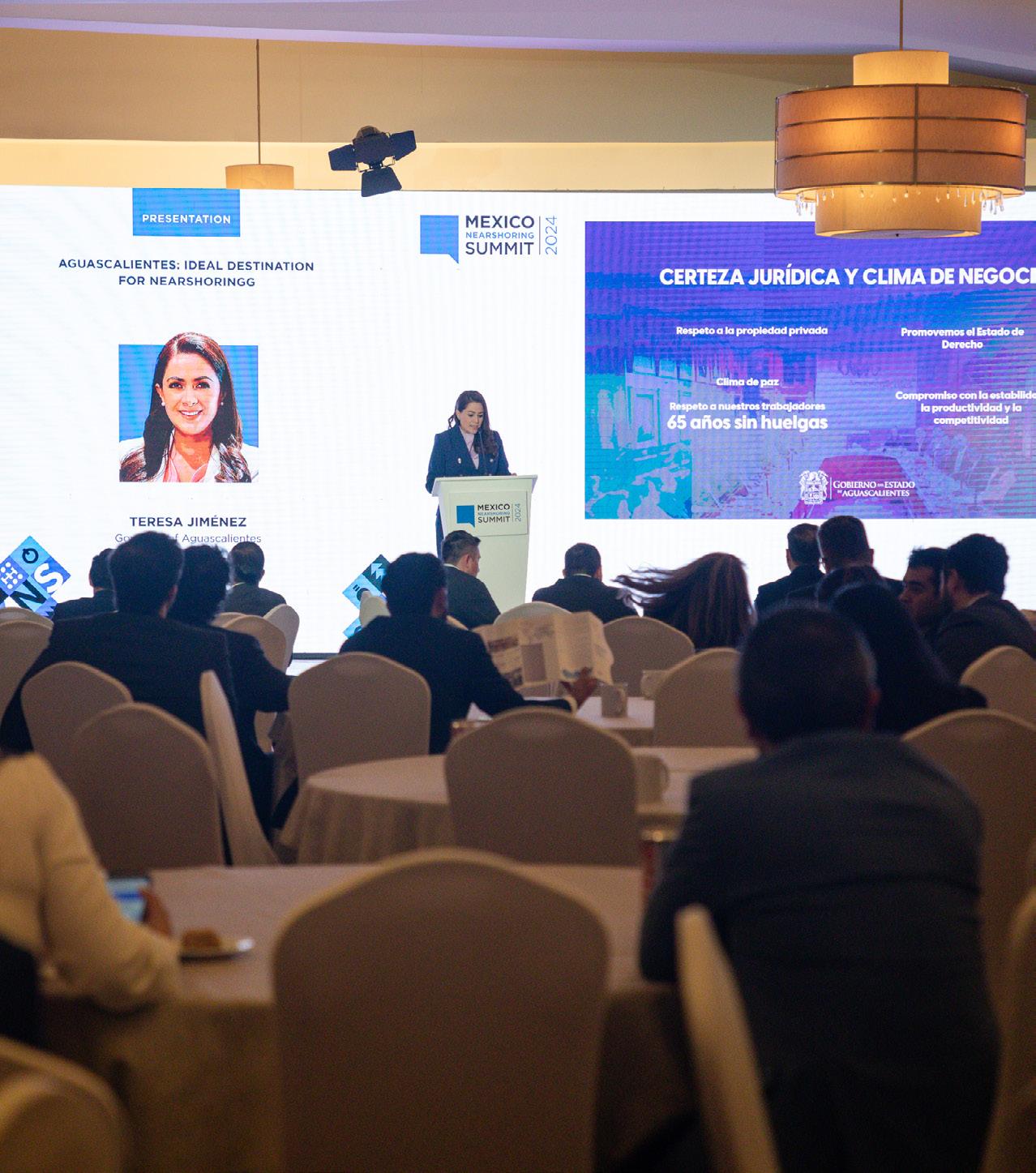
10
TIME TO CAPITALIZE ON MEXICO’S NEARSHORING MOMENTUM
Mexico finds itself at the forefront of nearshoring investment considerations for businesses seeking to optimize their supply chains and enhance operational efficiency. Recognizing the significance of this opportunity, economic development ministers from various states are doubling down on efforts to showcase the unique advantages and investment potential of their respective regions.
Marco Antonio Del Prete, President of the Association of Mexican Ministers of Economic Development (AMSDE), highlighted the unprecedented opportunity that nearshoring presents to Mexico and its constituent states. Focused on the imperative of harnessing this momentum, Del Prete underscored the concerted efforts of economic development ministers across Mexico to attract investments, foster connections, and address the needs of companies considering relocation to th e country.
Del Prete explained that nearshoring is not a new phenomenon to Mexico, citing its historical utilization during the 1970s and 1980s when maquiladoras flourished, capitalizing on Mexico’s lower labor costs. However, nearshoring has adapted to contemporary challenges, notably during the CoVID-19 pandemic, which disrupted global supply chains and prompted companies to seek closer proximity to their markets. This strategic shift has allowed businesses to reduce time and costs, leverage local talent, and avoid compounding challenges such as the container crisis.

“We have to promote our capabilities, encourage exports, ensure the best infrastructure and boost renewable energy projects to promote Mexico’s economic and sustainable development”
Marco Antonio del Prete President, AMSDE
Del Prete emphasized that nearshoring is increasingly influenced by climate change, as companies strive to minimize their carbon footprint by decreasing export distances. This trend is incentivizing businesses to establish closer relationships with both suppliers and customers, enabling them to pursue net-zero goals more eff ectively.
“Nearshoring involves more than just relocating plants; it encompasses the relocation of entire processes. While other strategies like friendshoring prioritize alliances, nearshoring primarily addresses logistical considerations. This presents a significant opportunity for Mexico, given its strategic geographic location between the Atlantic and Pacific oceans, its proximity to the United States, a competitive labor force, and numerous trade agreements facilitating smooth business operations for foreign companies, ” said Del Prete.
Economic development ministers are keenly aware of these strengths and are actively promoting them to prospective investors. However, amidst the promising prospects of nearshoring, several challenges loom on the horizon including those related to energy infrastructure, availability of industrial real estate, legal certainty, and a skilled workforce to boost competitiveness.
In the realm of energy, efforts are underway to bolster infrastructure and ensure a reliable supply to support industrial growth. Initiatives aimed at enhancing vocational training and upskilling programs are being rolled out to meet the demand for skilled labor in key sectors. “We have to promote our capabilities, encourage exports, ensure the best infrastructure and boost renewable energy projects to promote Mexico’s economic and sustainable development,” said Del Prete.
The holistic approach taken by economic development ministers underscores a shared
Co NFERENCE H IGHLIGHTS 11
commitment to unlocking Mexico’s full potential as a premier nearshoring destination. By listening to the needs of businesses and proactively addressing challenges, these ministers are paving the way for sustained economic growth and prosperity across the country.
Furthermore, the minister aims for Mexico not only to leverage new technologies but also to be at the forefront of their creation.
“We cannot persist solely as maquiladoras, reliant solely on foreign investment. It is imperative that we invest in technology, innovation, and the development of local suppliers, not just to provide solutions, but to originate them from the ground up.”
As Mexico continues to capitalize on its nearshoring momentum, the role of economic development ministers remains paramount as it will facilitate inter-government coordination.
VITAL VECTORS TO MEXICO’S NEARSHORING COMPE TITIVENESS
To ensure sustained growth and competitiveness amidst Mexico’s nearshoring transformation, companies must develop a strategy that encompasses energy, infrastructure, and talent, according to industry experts. Addressing these aspects holistically is imperative for businesses aiming to fortify their positions in Mexico’s nearshoring ecosystem. This approach serves as a proactive means to navigate the challenges and opportunities that lie ahead.
In the pursuit of nearshoring excellence, fostering a strategy centered on innovation becomes paramount. This involves not only leveraging technological advancements but also cultivating a collaborative environment where energy efficiency, infrastructure development, and talent cultivation converge. By strengthening these elements, companies can effectively capitalize on synergies between these vital vectors, thereby enhancing their competitive edge and positioning themselves as frontrunners in the nearshoring arena.
This necessitates a comprehensive understanding of the unique advantages inherent in each region, explains Armando Zúñiga, President, Co PARMEX CDMX. He emphasizes the geographical diversity across regions, emphasizing the need to capitalize on these differences through the formation of regional blocs to maximize investment opportunities. However, Zúñiga underscores the importance of states collaborating to attract investments and address common challenges prevalent in
Mexico’s nearshoring landscape. “State strategies,” he asserts, “must encompass not just energy accessibility, but also focus on renewable energy, robust transmission infrastructure, and the cultivation of skilled talent, shifting away from reliance solely on low-cost labor,” Zúñiga added.
Energy
Luis Roberto Arechederra, Minister of Economic Development, State Government of Jalisco, underscores the pressing need for states to align with decarbonization policies driven by large corporations. He emphasizes that an established decarbonization pathway is essential for states to fully meet the expectations of these corporations. “This strategy,” Arechederra asserts, “must permeate the entire supply chain and be reinforced through the adoption of energy-efficient practices and technological investments.” By aligning with these corporate sustainability initiatives, states can not only attract investment but also foster a more sustainable business ecosystem.
Drawing from the experiences in Veracruz, Enrique Nachón García, Minister of Economic and Port Development, emphasizes the necessity of a triple helix approach involving government, industry, and academia to harness synergies in energy infrastructure development. Nachón highlights the increasing adoption of Environmental, Social, and Governance (ESG) guidelines by companies, underscoring the importance
Co NFERENCE H IGHLIGHTS 12
of aligning governmental policies and academic research with corporate sustainability objectives.
Veracruz’s significant energy surplus, producing three times more energy than it consumes, positions it as a compelling destination for industries seeking reliable energy sources. Nachón emphasizes the potential of energy surplus in Veracruz as a magnet for industrial relocation. Furthermore, he stresses the significance of infrastructure development projects, such as the Tehuantepec isthmus project, as crucial opportunities for regional collaboration. This project, while promising, requires coordinated efforts with neighboring states like oaxaca, highlighting the necessity for interregional cooperation in infrastructure development. Arechederra adds, “For effective collaboration under the triple helix model, governments must take proactive steps to deploy relevant public policies that integrate all stakeholders.”
Talent
The availability and quality of talent are paramount in shaping the infrastructure planning and development crucial for successful nearshoring operations, especially within energy-intensive industries. A highly skilled workforce not only drives innovation but also significantly impacts the design and optimization of infrastructure tailored to meet the diverse needs of various sectors. Therefore, companies must prioritize talent development initiatives alongside infrastructure investments to cultivate a conducive environment for sustainable growth and operational efficiency.
In this context, the state of Durango has grappled with talent outflow. Arturo o rtiz Galán, Vice Minister of Economy, State Government of Durango, highlights that approximately 45% of the state’s talent migrates elsewhere in pursuit of opportunities. He identifies the historical underutilization of investment attraction as a key factor contributing to this trend, albeit presenting a newfound opportunity.
“Despite missing out on investment opportunities for two decades,” Galán notes, “this gap has transformed into an advantage.”
Conversely, Durango boasts a wealth of available talent, supported by 72 universities and 78 technical schools. Galán underscores that these educational institutions equip professionals with the requisite skills to capitalize on opportunities within the state. Furthermore, he emphasizes Durango’s potential to strategically shape and diversify its industrial landscape, leveraging its abundant ta lent pool.
Triple Helix
Government support plays a pivotal role in fostering a holistic approach to infrastructure development and talent cultivation essential for Mexico’s nearshoring activities. By implementing policies that promote energy efficiency and workforce development, governments can create an enabling environment conducive to nearshoring ventures. Collaborative efforts between the public and private sectors are imperative to address infrastructure gaps, enhance regulatory frameworks, and

Co NFERENCE H IGHLIGHTS 13
establish industry standards that ensure the long-term viability of nearshoring ventures.
“In Veracruz we recognized that to act the most important thing was to first have a diagnosis and we also learned a lot from other states. Another strategy that worked in our state was to pay special attention to the paperwork process and create a unit that united the different people involved in these processes so that when the investments arrive, we all listen to the projects at the same time and find ourselves on the same page,” said Nachón.
The consensus among government officials underscores the significance of actively engaging with companies and guiding the orderly development of the industry. Implementing public policies that foster a triple helix model—embracing collaboration among government, private sector, and academia—is deemed essential. Ulises Fernández, Minister of Innovation and Economic Development, State Government of Chihuahua, identifies the circular economy as a promising avenue for decarbonization and industry development. He highlights the potential of repurposing industrial surpluses and optimizing processes to foster sustainability and resource e fficiency.
“There are important issues of use within companies to develop a circular economy. For example, surpluses from industries such as the automotive industry can be reincorporated, or industrial processes can be circumscribed for the use of other industries, that is an interesting strategy to explore,” said Fernández.
Capitalizing on Strengths
From Chihuahua, Fernández elucidates that nearshoring is not merely viewed as a solution but as a profound opportunity to strategically direct new investments and cultivate the business ecosystems of the future. “In Chihuahua,” Fernández explains, “we have implemented intelligent specialization strategies, focusing on key automotive sectors such as electronics, aerospace, automotive, and medical equipment. Capitalizing on the development of specialized talent in these sectors is paramount.” Fernández emphasizes the importance of retraining personnel to adapt to evolving operational processes, ensuring alignment with the demands of incoming industries.
In the central region of the country, San Luis Potosí emerges as a vital logistical hub. Salvador González, Head Representative, Government of San Luis Potosí in Mexico City, highlights the state’s recent resurgence in investment activity. González attributes this resurgence to the state’s strategic geographical location at the heart of the country, facilitating crucial processes within the industrial production chain. “With these investments in mind, we have promoted infrastructure on the priority agenda and established a commitment to various sectors, generating direct communication with users of the industrial sector to attract more investments and develop satellite companies, the productive chain,” says Gonzalez.
Furthermore, government ministries underscore the importance of crafting

Co NFERENCE H IGHLIGHTS 14
State Development Plans that articulate clear strategies for orderly economic development, leveraging the unique strengths and opportunities of each state. Additionally, Zúñiga acknowledges that despite potential differences in political affiliations, economic development
ministries across Mexican states are collaboratively steering efforts to maximize the benefits of nearshoring. This concerted approach aims to harness valuable knowledge and experience to propel regional development during this critic al period.
THE ENERGY FACTOR: DECARBONIZING MEXICO’S AUTOMOTIVE INDUSTRY
With estimates suggesting that electric vehicles (EVs) could constitute up to 75% of automotive sales by 2030, the imperative to decarbonize Mexico’s automotive sector becomes increasingly apparent, as highlighted in discussions at Mexico Nearshoring Summit 2024. Decarbonization, however, does not only refer to electrification but to how the electricity consumed by vehicles is generated.
Experts shed light on the pressing need to reduce carbon emissions, particularly in Mexico’s automotive industry as it accounts for a significant portion of Co2 emissions. o ne of the pivotal discussions revolved around the role of energy consumption.
According to Ivette Castillo, General Manager of GSI LAM, GE Grid Solutions, the adoption of electric vehicles (EVs) is pivotal in reducing Co2 emissions. “In less efficient energy generation matrices, EVs can reduce emissions by approximately 25%. This can surpass 75% with more effective matrices,” says Castillo.
Juan Cerdeira, General Manager, SEV Mexico, emphasized the importance of offering comprehensive ecosystems to end-users, including solar panels, inverters, batteries, and affordable EVs, given that up to 80% of owners charge their cars at home. “By providing accessibility to EVs priced below MX$300,000 (US$17,850), consumers can not only reduce their carbon footprint but also generate the energy they consume, thereby contributing significantly to decarbonization efforts’’.
Edgardo Pereida, Director of Infrastructure, Bose Group, highlighted the global shift
toward carbon footprint reduction policies, with European legislation mandating the phasing out of internal combustion engine vehicles by 2035. Highlighting the scarcity of providers offering 100% clean energy in Mexico, the discussion pivoted toward combined-cycle power plants as the next viable option. “However, constraints within legislation regarding generation, distribution, and final delivery pose significant challenges for those seeking alternative solutions,” says Pereida.
Despite the momentum toward decarbonization, challenges persist. Castillo pointed out the bottleneck in energy transmission due to limited infrastructure. Resolving this issue requires long-term integrated planning and substantial investments in infrastructure to ensure widespread benefits.
Addressing the constraints posed by saturated energy networks, Cerdeira emphasized the importance of small-scale, self-sufficient generation units. “Even larger infrastructure projects, such as charging stations, are hindered by the capacity constraints of CFE across different regions of Mexico,” he says.
Nearshoring presents a significant opportunity for Mexico’s automotive industry and its decarbonization goals. However, achieving these objectives by 2030 and 2050 demands substantial investments and clear strategic planning, agree experts. As Pereida stated, decarbonization is not merely an option but an obligation for Mexico’s automotive sector, demanding a swift transition to clean, renewable, and sustainable energy sources.
Co NFERENCE H IGHLIGHTS 15
BEATING GRID LIMITATIONS TO ENSURE ENERGY SUPPLY SUCCESS
While enthusiasm for nearshoring in Mexico is evident from the influx of capital, it has yet to materialize into commensurate energy infrastructure development—a critical component for nearshoring success among companies. In an exploration of the intricacies surrounding energy infrastructure and supply chain dynamics, Mario Cavazos, Business Development Manager at Aggreko, offers insights into innovative strategies aimed at overcoming grid limitations and ensuring a dependable energy supply for industries.
one of Cavazos’ key takeaways underscores the significance of producing goods close to the final consumer. This strategy not only reduces transportation costs but also mitigates vulnerabilities associated with lengthy supply chains. The concept of nearshoring, often synonymous with Mexico, transcends mere relocation of operations to neighboring countries. It encompasses optimizing supply chains to efficiently fulfill consumer demands while diversifying investments across various regions.

“Nearshoring is not confined to Mexico alone; countries like the Philippines, Vietnam, and Brazil also reap substantial benefits from this phenomenon”
Mario Cavazos Business Development Manager, Aggreko
noted Cavazos, underscores the nation’s burgeoning industrial landscape.
Mexico has experienced a significant influx of investment in recent years, largely attributed to the nearshoring trend. While states in the northern region have garnered the highest levels of investment, notable investments have also been made in southeastern states such as yucatán and Veracruz. Key sectors attracting substantial investment include the automotive sector, accounting for 34%, followed by the manufacturing sector at 19%, and the logistics and distribution sector at 12%. “Amidst ongoing market restructuring, nearshoring emerges as the primary catalyst reshaping supply chains within the automotive industry,” observed Cavazos.
However, Mexico has emerged as a focal point for nearshoring investment in recent years, particularly in its northern states, attracting substantial capital influx. The proliferation of new industrial parks exemplifies the country’s dedication to fostering industrial development. Key sectors such as automotive, manufacturing, and logistics have witnessed significant investments, contributing to economic growth and job creation. “The remarkable increase in the number of industrial parks in Mexico by 50% from 2019 to 2022,”
However, despite the promising growth trajectory, challenges persist, particularly in the realm of energy infrastructure. The limited expansion of the national transmission network, as highlighted by data from the Secretariat of Energy (SENER) and the Mexican Institute for Competitiveness (IMC o ), underscores the urgency of addressing infrastructure constraints. Instances of alert and emergency operational states due to network failures, lack of infrastructure, and adverse weather conditions underscore the critical need for investment in energy infrastructure. Therefore, it is well acknowledged that among the primary challenges of nearshoring are access to electrical energy, availability of clean energy, waiting time for access to the network, continuity and quality of electrical supply, water supply, road and port infrastructure, and security.
“The lack of infrastructure and failures in the National Transmission Network, coupled with climatic issues in some cases, lead to increased intermittency and variability in frequencies and voltages. This results in production losses for companies working with thermoformed plastics or fiberglass industries,” said Cavazos.
Co NFERENCE H IGHLIGHTS 16
Given the substantial energy demand anticipated, infrastructure poses a significant concern for investors. An analysis of projects directed by the Ministry of Energy (SENER) for the national transmission network, as reported by the Mexican Institute for Competitiveness (IMC o), reveals minimal growth. Between 2020 and 2022, the length of transmission lines increased by only 0.17%, totaling 110,685 kilometers in 2022 compared to 110,497 kilometers in 2020. Furthermore, from 2015 to 2022, SENER instructed the CFE Transmission on 192 projects for expansion and modernization of the National Transmission Network (RNT), and 126 projects for expansion and modernization of the General Distribution Network (RGD) to CFE Distribución.
Aggreko offers customized solutions to tackle these challenges head-on. From balancing seasonal demands to bridging power gaps during scheduled maintenance or unexpected shutdowns, Aggreko delivers flexible and dependable power generation solutions. Leveraging its expertise in energy consulting, Aggreko assists in identifying opportunities for cost savings and facilitates the transition to more efficient generation assets. This not only enhances energy resilience but also reduces operational costs.
Despite Mexico’s significant strides in attracting nearshoring investment, there persist areas of concern, notably legal uncertainty, competitiveness, and the adoption of renewable energy. As Mexico consolidates its position as a pivotal trading partner with the United States, addressing these challenges becomes imperative to fully harness the potential of the nearshoring phenomenon. “It is not merely about rhetoric but about decisive action,” emphasized Cavazos.
ENERGY INFRASTRUCTURE DEVELOPMENT FOR MANUFACTURING GROWTH
Mexico stands at the forefront of the next generation of manufacturing in the world where the strategic development of energy infrastructure emerges as a pivotal element for ensuring sustained growth. By addressing critical considerations and leveraging lessons from successful global investments, Mexico can navigate challenges and capitalize on opportunities to propel its manufacturing sector forward.
Strategic planning for energy infrastructure in manufacturing necessitates careful consideration to prevent energy constraints from impeding economic growth in Mexico. The country faces a constrained grid that limits interconnection and subsequently hinders its capacity to support larger renewable energy projects. This grid limitation has led the government to restrict solar projects, prompting a need for alternative solutions such as distributed generation, albeit with a current limit of 500KW.
In the context of nearshoring in Mexico, Rodolfo Rueda, Partner, Holland & Knight LLP, explains: “A well-structured nearshoring scheme is paramount for driving Mexico’s energy transition. Without this transition, the development of grid transmission infrastructure will be hindered, ultimately impeding investment opportunities.” He adds that “without the generation of an appropriate nearshoring scheme, there will be no transition; without transition, there will be no transmission, and without transmission, there will be no investment.”
Despite the 500 KW limit, Víctor Mejía, Chief Commercial o fficer, Energía Real, sees it as an opportunity, stating: “The 500kW limit for distributed generation is no longer a barrier. Renewable energy certificates offer proof of commitment, and even isolated supply can count towards installed capacity.” The 500KW limit can be surpassed with storage systems as long as there is no grid injection—a
Co NFERENCE H IGHLIGHTS 17
solution showcasing a commitment to decarbonization. o perational continuity batteries and energy backup systems can also be profitable investments, contributing to sustainability. The evolution we see is in a mix of technologies to address energy issues so that companies can be more competitive and demonstrate a path to susta inability.
“Another challenge lies in the issue of government administrations, as it changes every 6 years. Integrating long-term strategic planning of infrastructure that encompasses logistics and provides a basis for continuity is essential. Volatility needs to change and necessitates having a roadmap for at least 25 years,” said Gonzalo Azcárraga, General Director Mexico, SENER.
Experts stress that addressing these limitations is crucial to leverage the opportunity that nearshoring represents. Moreover, federal energy policy, influenced by the factors mentioned above, has also focused on rescuing state companies such as PEMEX and CFE, leading to cheaper fossil-fueled energy. However, this presents another concern for the industry as offtakers increasingly demand cleaner energy sources.
Planning
Strategic planning for energy in the manufacturing industry, particularly in the automotive sector, entails careful consideration during a transitional period toward decarbonization. Mexico’s path to ensuring energy supply at this juncture involves advancing toward renewable
energies and decarbonization. Priorities include capacity for evacuation and transmission. However, energy needs extend beyond electricity; they also encompass port infrastructure, railways, airports, transportation, and logistics, which still heavily rely on fossil fuels.
As Mexico emerges as a nearshoring hub for manufacturing, especially in the automotive sector, planning becomes paramount. Priorities encompass not only planning but also devising a financing scheme as the transition requires significant investment, borne by the market. The challenge lies in planning the transition while ensuring a continuous energy supply and managing investment costs,” emphasizes Josefa Casas, Senior Associa te, Doxia.
“Sustainability encompasses more than decarbonization and environmental impact; it extends to the communities where infrastructure is developed, encompassing social, economic, and environmental aspects. It involves considering the entire supply chain, not just focusing on the plant area. Logistics, for instance, significantly impact carbon footprints. It’s about caring for the entire process, involving every sector and ensuring supply chain integrity,” said Casas.
Short-term v. Long-term P riorities
In the current scenario, it is imperative for companies to prioritize investments in diverse energy sources and technologies to mitigate risks associated with supply shortages or price volatility. Additionally,

Co NFERENCE H IGHLIGHTS 18
enhancing energy efficiency measures and promoting renewable energy integration can bolster resilience and competitiveness within the manufacturi ng sector.
Achieving a balance between short-term energy needs and long-term growth objectives requires a multifaceted approach. While immediate energy requirements must be met to sustain manufacturing operations, simultaneous efforts should focus on implementing sustainable practices and infrastructure upgrades. This involves investing in advanced technologies, fostering innovation, and collaborating with stakeholders to develop comprehensive energy strategies aligned with long-term growth trajectories.
Marco Cosío, Vice President for Smart Infrastructure, Siemens Mexico, Central America & Caribbean, emphasizes the role of technology in this endeavor: “The constant interaction makes digitization essential. We utilize technology such as software and AI to achieve reductions. Digitization enables dynamism, equipping companies with capabilities to make intelligent decisions. Technology must have a purpose and be based on digitization.”
As highlighted by experts, Mexico’s energy market is relatively new, with solar energy rapidly advancing as the cheapest energy source globally. This shift underscores the decreasing need for subsidies and highlights the importance of strategic investments in renewable energy to drive decarbonization efforts within the Mexican energy sector.
Lessons From Abroad
Mexico can glean invaluable insights from successful investments in grid and electrical infrastructure across the globe. Emphasizing robust planning processes, streamlined execution, and effective ongoing management are paramount. By studying best practices from countries with advanced energy infrastructures, Mexico can enhance project efficiency, optimize resource allocation, and mitigate potential pitfalls, thereby accelerating the pace of development and improving overall system reliability.
The attraction of private investments for energy infrastructure projects presents both challenges and opportunities. While financial barriers may deter private sector involvement, collaborative efforts between the public and private sectors can mitigate risks and unlock opportunities for investment. Public-private partnerships (PPPs) can offer innovative financing mechanisms, risk-sharing frameworks, and regulatory incentives to attract private capital. By fostering an enabling environment for investment and promoting transparency, Mexico can harness the potential of private sector participation to drive energy infrastructure development and support the growth of its manufacturing sector.
“The problem lies in finding these sources of financing, in PPPs, changes in laws that are not within our control. The acceleration or speed would be different if investment in PPPs were opened up,” said Cosío.
ADEQUATE, CLEAN, AFFORDABLE ENERGY: XÓCH ITL GÁLVEZ
The current state of the energy sector cannot sustain the wave of nearshoring due to the closure of opportunities for private investment, as highlighted by Fernando Zendejas, Deputy General Energy Coordinator, Board for Xóchitl Gálvez during the Mexico Nearshoring Summit. This closure represents a significant barrier
to economic growth and innovation within the sector.
“We are committed to fostering a fair energy transition, streamlining processes, and enhancing competition within the energy sector to effectively address the evolving demands of both the market and
Co NFERENCE H IGHLIGHTS 19
the populace,” said Zendejas. However, he underscored the challenges posed by the current administration’s policies, citing that 97% of alerts generated within the energy sector are attributed to faults in transmission and distribution networks.
Even though Mexico has a unique opportunity presented by the current geopolitical climate, there are significant hurdles within Mexico’s energy policy framework, such as bureaucratic processes that delay projects and a lack of safety. To overcome these challenges, it is imperative to uphold the rule of law, as emphasized by Zendejas. This serves as a stark reminder that disregarding established processes not only impedes progress but also deters private investment—a critical issue compounded by “outdated perspectives reminiscent of the 1970s.”

“We need to ensure an efficient and sustainable nearshoring scheme to meet the needs of companies, while also protecting the constitutional integrity of the process to promote the development and transparency of the industry”
Fernando Zendejas General Deputy Coordinator of the Energy Board for Xóchitl Gálvez
“We need to ensure an efficient and sustainable nearshoring scheme to meet the needs of companies, while also protecting the constitutional integrity of the process to promote the development and transparency of the industry,” said Zendejas.
The energy transformation proposals from Xóchitl Gálcez presented during the conference regarding the importance of ensuring sufficient, secure, and affordable energy as we transition towards cleaner sources—a goal that necessitates simplified and enhanced competition within the sector.
Renewable energy and the sustainability of state companies stand out as prominent proposals advocated by Gálvez. These initiatives are intricately linked with overcoming bureaucratic obstacles that impede market expansion, all with the overarching goal of enhancing the economic development of Pemex and CFE. In 2023, state companies attracted investments amounting to MX$2.5 trillion, equivalent to 10% of GDP.
However, despite this substantial investment, sustainable production remains elusive. As highlighted by Zendejas, CFE’s current production capacity stands at 53GW, whereas 25GW is deemed necessary to adequately support nearshoring initiatives.
THE FUTURE OF NATURAL GAS AND LNG IN MEXICO ’S ECONOMY
The transition fuel, liquefied natural gas (LNG), is playing a pivotal role in Mexico’s natural gas industry, offering diverse opportunities for businesses to thrive amidst evolving market dynamics. In the same manner that the country stands as a nearshoring hub, its crucial location positions Mexico as a central hub for LNG and LNG exports, says Vania Laban, President, Mexican Association of Natural Gas (AMGN).
Mexico possesses access to the most affordable natural gas globally, a critical advantage as nations endeavor to transition their economies and industries towards
cleaner energy sources while maintaining reliability and productivity, as highlighted by Laban. However, Mexico’s primary challenge lies in bridging the gap within its gas infrastructure.
Natural gas generates 50% fewer emissions than oil in power generation. Reliable and affordable energy is also susceptible to disruptions stemming from unforeseen factors, including geopolitical conflicts or health emergencies, as evidenced by events over the past five years. In light of these benefits, LNG emerges as a promising alternative to mitigate such potential disruptions.
Co NFERENCE H IGHLIGHTS 20
Ana Ludlow, VP Chief Government Affairs & Sustainability o fficer, ENGIE Mexico, emphasized the unique characteristics of LNG, stressing the need for tailored taxation policies. Instead of applying conventional fuel taxation to LNG, Ludlow proposes incentivizing its adoption and utilization. “Advancing in the pursuit of decarbonization alternatives requires leveraging the potential of gas,” she asserted. “This entails not only attracting new investors through nearshoring but also enhancing the competitiveness of the industry already established in the country.”
Understanding the significance of natural gas and exploring avenues for diversification within this sector are essential for companies aiming to enhance resilience and capitalize on emerging market opportunities. By delving into key market dynamics, infrastructure development, policy implications, and collaborative strategies, businesses can navigate the complexities of Mexico’s natural gas landscape and position themselves for sustainable growth.
Sergio Romero, Regional Vice President of Regulation and Public Affairs at Sempra Infraestructura, emphasized that the government bears the responsibility of establishing regulatory frameworks, while the decision to investment lies with stakeholders. “With over 28 years of sustained investment, our dedication is rooted in the industry’s strong foundation and the inevitable surge in energy demand fueled by offshoring. Nevertheless, it is crucial to acknowledge that private investment ought to complement public
initiatives, thereby forming a unified strategy to tackle the dynamic energy landscape.”
Infrastructure development plays a crucial role in unleashing the full potential of natural gas and LNG in Mexico. “We need infrastructure because we are missing opportunities not only in the energy sector but across the country. Where we need the most investment is in lastmile infrastructure,” said Alejandro Peón, Country Manager Mexico, Naturgy Mexico.
He emphasized that investments in pipeline networks, storage facilities, and liquefaction terminals are vital for facilitating the efficient transportation and distribution of natural gas resources. Companies have the opportunity to contribute and capitalize on this development by collaborating with government entities and industry stakeholders to streamline infrastructure projects and enhance connectivity across the sup ply chain.
Existing and evolving policies and regulations significantly impact the future trajectory of natural gas and LNG in Mexico. Companies must proactively navigate this regulatory landscape by advocating for favorable policies, complying with regulatory requirements, and mitigating potential risks associated with regulatory changes. Adopting a proactive approach to policy engagement enables businesses to align their strategies with evolving market dynamics and regulatory frameworks, fostering long-term sustainability and growth.

Co NFERENCE H IGHLIGHTS 21
“Public policies have the potential to significantly bolster infrastructure development. With collective agreement and alignment, these policies can be further refined and strengthened. Armed with stable and dynamic regulatory frameworks, companies are empowered to concentrate their efforts on the strategic deployment of infrastructure, thereby fostering the growth and vitality of development parks,” said Peón.
The future of natural gas and LNG in Mexico’s economy is influenced by various market dynamics, including fluctuating global energy demand, geopolitical factors such as the Ukraine war, and technological advancements. Companies must remain agile in response to these dynamics, embracing innovation and flexibility to adapt to changing market conditions swiftly. By staying abreast of market trends and consumer preferences, businesses can identify niche opportunities and tailor their offerings to meet evolving demands effectively.
Collaboration and partnerships are integral to fostering a more integrated and
sustainable natural gas ecosystem in Mexico. Across various stages from exploration and production to distribution and consumption, companies can capitalize on collaborative initiatives to optimize resource utilization, improve operational efficiency, and foster innovation throughout the value chain. Encouraging a culture of collaboration and knowledge exchange within businesses can generate synergies that positively impact all stakeholders, thereby advancing the growth and development of Mexico’s natural gas industry.
“ With vast opportunities ahead, including unmatched access, infrastructure, and potential for extensive transportation networks, our regulatory market must evolve to foster collaboration between stakeholders and regulators. Effective communication is crucial in this pivotal sector, as we strive to elevate natural gas beyond its traditional role and harness its potential for sustainability. It is our responsibility to expedite this transition, accelerating progress towards a greener future,” said Laban.
UNLEASHING SOLAR POTENTIAL TO GUARANTEE SUSTAINABLE ENE RGY SUPPLY
Solar energy emerges as a promising solution within Mexico’s energy sector, providing a viable pathway toward sustainability. Through an examination of Mexico’s present standing in solar energy, coupled with technological advancements and the potential for distributed generation and energy storage, stakeholders are set to unlock the full potential of solar energy, thereby guaranteeing a sustainable and dependable energy supply for the future. Prevailing challenges, such as infrastructure constraints, however, have limited the utilization of these energy generation systems.
Mexico continues to grapple with critical infrastructure constraints, particularly concerning the expansion and modernization of its electrical grid to
guarantee a reliable electricity supply. This issue becomes especially imperative in regions characterized by robust industrial development, where there is a notable uptick in energy demand. Furthermore, in underdeveloped areas, improving this infrastructure has the potential to act as a catalyst for heightened industrial investment.
Currently, Mexico possesses abundant solar resources, making it an ideal candidate for solar generation. Embracing solar energy not only contributes to sustainability but also reduces dependence on fossil fuels and mitigates environmental impacts associated with traditional energy sources. Empowering the end-user to make decisions regarding their energy consumption marks a significant shift, driven by technological advancements. “In a country where 90% of households are
Co NFERENCE H IGHLIGHTS 22
domestic, reducing dependency on the grid is inevitable,” said Jorge Musalem, Strategic Projects Manager, CFE.
The increased utilization of solar is key for Mexico to advance in its energy transition, but also to ensure the continued harnessing of the benefits that nearshoring has brought to the national economy. “Mexico is in a particular condition not only due to nearshoring but also because its generation matrix relies on fossil fuels,” said Nelson Delgado, General Manager, AS o LMEX. “If we are not capable of generating solar energy, nearshoring will slip away from us,” added Zúñiga.
To enhance the adoption of solar energy and improve Mexico’s energy supply, stakeholders must prioritize the implementation of solar projects and invest in infrastructure to support distributed generation.” If we generate and store energy at the point of consumption, rather than transporting it, costs are reduced. It is only a matter of time before users start to opt out of the grid,” said Musalem.
“We want to power industrial parks, yet we see almost 100% of the rooftops empty. There is very limited photovoltaic solar generation,” said Ricardo Zúñiga, Country Manager, CapWatt.
Another challenge facing the solar industry in Mexico is the lack of transmission infrastructure to accommodate the growing demand for renewable energy. To address this issue, DG has appeared as a crucial alternative. These systems have experienced significant growth, notably led by Jalisco,
marking its most successful year to date. Despite limitations such as a maximum capacity of 0.5MW per installation, which falls short compared to Brazil’s 5MW capacity, the sector has seen a remarkable surge of 49% since 2019. This highlights a notable shift toward renewable energy participation, despite initial governmental reservations. By the end of 2023, DG had attracted investments totaling US$4.5 billion, with an installed capacity of 3,300MW, according to CRE.
From a technological standpoint, significant advancements have been made in the implementation of photovoltaic projects in Mexico. Innovations in solar panel efficiency, energy storage systems, and grid integration technologies are revolutionizing the solar industry, rendering solar energy more accessible and cost- effective.
“Efficiency rates of modules have surpassed 20%, compared to previous standards, utilizing less space and incorporating bifacial technology. These advancements have led to increased efficiency, reduced degradation, and maintained high performance over time,” said Iván Reyes, Utilities Director, LoNGi Solar. By leveraging these advancements, stakeholders can overcome technical barriers and accelerate the deployment of solar projects, driving the sustainable energy transition across the country. Moreover, the solar industry must educate stakeholders on the economic benefits of various technologies, extending beyond installations up to 500kW, according to Musalem. Furthermore, incentivizing industrial adoption through diverse business

Co NFERENCE H IGHLIGHTS 23
models is crucial for widespread acceptance, explained Zúñiga.
The economic viability of solar energy presents an attractive proposition for industry development. According to a report by the Mercom Capital Group on corporate financing within the solar sector in 2023, there was a notable 42% yearon-year increase in global financing. This report meticulously tracks venture capital, public market, and debt financing activities, revealing a substantial total of US$34.3 billion raised across 160 deals in 2023. This represents a significant surge compared to the US$24.1 billion raised through 175 transactions in 2022, marking the highest level of corporate financing within the solar sector in the past decade.
AME: STRATEGIC VISION 2030
The Mexican Energy Association (AME) unveiled its strategic vision for the nation’s electric industry in 2030, emphasizing the imperative of investing in addressing energy transmission and distribution challenges. This vision was articulated by Gumersindo Cué, Executive Director of AME.
AME is comprised of 22 electric energy generating companies, boasting a collective capacity of 37,240 Megawatts, with an accumulated investment of US$30 billion over time.
Additionally, the consortium encompasses 15 affiliated entities specializing in clean energy generation, technology, consulting, law firms, and engineering services. Notably, approximately 65% of the energy generated by AME is derived from combined cycle methods, with wind energy contributing 16% and solar-photovoltaic contributing 11%. The remaining 8% encompasses various sources including cogeneration, gas turbines, thermoelectric processes, internal gas combustion, and battery technology.
“AME companies possess the requisite expertise, robust resources, advanced technologies, and comprehensive market
Solar photovoltaic generation holds immense potential to guarantee a sustainable energy supply in Mexico. By embracing solar energy solutions, leveraging technological advancements, promoting distributed generation, and addressing infrastructure constraints, stakeholders can unlock the full benefits of solar energy and pave the way for a cleaner, more resilient energy future, agree experts.
“All that is new requires adaptation, especially when it comes to such an essential service as electricity. Now, meeting the transition is imperative, with numerous challenges and hurdles ahead,” said Alessandra Amaral, Executive Director, ADELAT.
penetration across all facets of the value chain, essential for championing and bolstering Mexico’s energy transmission,” said Gumersindo Cué, Executive Director, AME.
A primary role of AME in the electric sector is to contribute to its development by identifying areas in the electric grid design that require strengthening. This is particularly crucial as the sector plays a pivotal role in enabling nearshoring policies for foreign companies in Mexico. This importance is underscored by the estimation of the Inter-American Development Bank, which suggests that leveraging Mexico’s potential in this regard could yield approximately US$75 billion for the country.
Identified areas of development encompass the provision of ‘accessible, clean, reliable, competitive, and affordable energy,’ with a paramount emphasis on traceability. This entails ensuring that energy sources are verifiable and certified as sustainable,” according to Gumersindo Cué.
Additionally, there exist significant regulatory opportunities. According to an exploratory study by Morgan Stanley, as
Co NFERENCE H IGHLIGHTS 24
many as 74% of companies indicate that regulatory procedures in the electric sector need to be streamlined. This finding resonates with a broader trend across industries where regulatory frameworks are being reevaluated to accommodate technological advancements and evolving market demands.
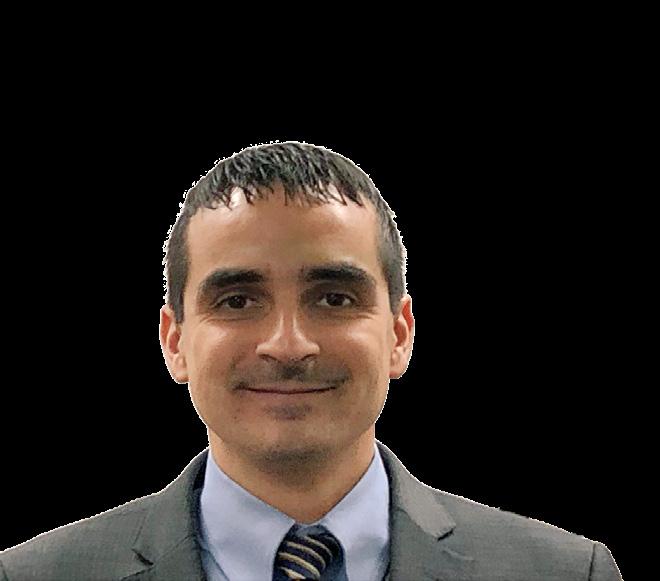
“AME companies possess the requisite expertise, robust resources, advanced technologies, and comprehensive market penetration across all facets of the value chain, essential for championing and bolstering Mexico’s energy transmission”
Gumersindo Cué Executive Director, AME
adopting new technologies, and fostering close collaboration between the private and public sectors in the electric sector. While the total capacity of the electric grid is 88 gigawatts, not all capacity is available at all times. In 2023, a historic demand of 53,000 megawatts was reached, with available capacity at that time being 57,000 MW, dangerously close to the infrastructure’s reliability limit.
The study also concluded that four major needs must be addressed to enhance electric transmission competitively. These include increasing generation capacity, investing in transmission and distribution networks,
According to estimates from Morgan Stanley, there is a need to increase the country’s energy capacity by 65% to cover up to 56 MW. Additionally, an extra 12.8 GW of capacity increase will be necessary within the next five years due to natural demand growth. However, to capitalize on the opportunities and needs presented by nearshoring policies, another 25 GW will be required within the same period. In summary, the country’s energy generation capacity must increase by at least 37 GW by 2029. Failure to address the country’s transmission and distribution problems could result in congestion costs equivalent to a loss of US$50 0 million.
CATEM’S ROLE: TAKING ADVANTAGE OF NEARSHORING IN MEXICO
Nearshoring presents both opportunities and challenges for Mexico’s labor force. Recognizing the importance of proactive engagement, Mexico’s Autonomous Confederation of Workers and Employers (CATEM) is playing a pivotal role in advocating for the rights and interests of workers amid the influx of investment and job opportunities associated with nearshoring.
At the core of CATEM’s mission is the empowerment of workers and the promotion of fair labor practices. Focused on harnessing the potential of nearshoring to benefit workers and communities, José Carlos Saavedra, Secretary of Foreign Relations, CATEM, underscored the confederation’s commitment to ensuring that labor rights are upheld and that workers are empowered in this shifting economic landscape.
Saavedra emphasized the need for collaboration between labor organizations, government agencies, and businesses to ensure that nearshoring initiatives translate into tangible benefits for workers. This includes advocating for fair wages, safe working conditions, and opportunities for skills development and career advancement.
CATEM is actively involved in fostering dialogue and cooperation between labor unions and companies to address the evolving needs of the labor market. By facilitating constructive engagement and negotiations, CATEM aims to strike a balance between the interests of workers and the imperatives of economic development.
Saavedra identifies three key conditions enabling the success of nearshoring in Mexico regarding talent:
Co NFERENCE H IGHLIGHTS 25
Mexico’s ratification of International Labor o rganization (IL o ) Convention 98 on freedom of association in 2018.
The 2019 Labor Reform in Mexico, which established conditions for operationalizing and implementing freedom of association, fundamentally altering the labor landscape
The enforcement of USMCA and its dispute resolution mechanism, which significantly impacted nearshoring decisions. This mechanism allows labor violations to be addressed, potentially resulting in trade sanctions against non-compliant labor centers, thus emphasizing the importance of considering evolving labor conditions for companies investing in Mexico.
“Mexico’s labor laws are among the world’s most modern, promoting extensive worker freedoms. However, these laws also impose greater responsibilities on unions, forcing them to uphold the standards outlined in the Labor Reform and USMCA. Failure to do so jeopardizes both jobs and investments,” states Saavedra.
Saavedra emphasizes the importance of Chapter 23, focusing on labor rights, and Chapter 31, addressing dispute resolution, in USMCA. He underscored the need for ongoing scrutiny of these chapters during the USMCA revision.
In addition to advocating for labor rights, CATEM is also focused on promoting inclusive growth and social development in communities affected by nearshoring activities. This entails supporting initiatives aimed at enhancing education, healthcare, and infrastructure to uplift the standard of living for workers and their families.
Despite the opportunities presented by nearshoring, CATEM remains vigilant against potential threats to workers’ rights and well-being. This includes concerns related to job insecurity, precarious employment arrangements, and the erosion of labor standards. By monitoring developments in the labor market and advocating for robust legal protections, CATEM seeks to safeguard the interests of workers in an ever-changing economic landscape.
THE MEXICAN GATEWAY TO GLOBAL CHINESE AUTO AND ENERGY INDUSTRIES
The arrival of Chinese automotive companies in Mexico marks a significant milestone in the globalization of the automotive industry. China, as a major player in the global automotive market, presents Mexican companies with opportunities for partnerships, investments, and technology transfers amidst the famous nearshoring trend.

Doing business with China has become increasingly accessible despite language differences, geographical remoteness, and prevailing prejudices”
Carolina Núnez Director General, China Chamber of Commerce and Technology Mexico
Carolina Núñez, Director General, China Chamber of Commerce and Technology Mexico, explains that doing business with China has become increasingly accessible despite language differences, geographical remoteness, and prevailing prejudices. The world is gradually recognizing China’s economic importance, which holds significant implications for Mexico.
China’s major economic hubs, including the yangtze River Delta, Beijing-Tianjin-Hebei, Chengdu-Chongqing Economic Circle, and the Guangdong-Hong Kong-Macau Greater Bay Area, serve as examples of long-term regional planning and development. The Greater Bay Area, celebrating its 10th anniversary, exemplifies China’s strategic planning, transforming former fishing outposts into bustling technological hubs
Co NFERENCE H IGHLIGHTS 26
like Shenzhen, often referred to as the Silicon Valley of Asia.
Translating China’s strategic development plans to Mexico’s context, Núñez emphasizes the potential benefits for Mexico’s automotive industry. Mexico’s strategic location, skilled labor force, established supply chains, and favorable trade agreements position it as an attractive destination for Chinese automotive companies seeking international expansion.
China’s automotive industry boasts global experience and market share dominance, representing 31% of the global automotive market. With explosive growth in recent years, China offers valuable expertise in electric vehicles (EVs), battery technology, and renewable energy—a potential source of technology transfer and knowledge exchange for Mexican companies.
Expanding on China’s EV industry growth, Núñez underscores the importance of communication and marketing strategies, which have enabled Chinese companies to capture significant market shares in Mexico. Leveraging Chinese practices, Mexico can optimize infrastructure development to support the adoption of new automotive
technologies, including charging stations and battery recycling facilities.
Núñez highlights the importance of fostering partnerships and collaboration between Chinese and Mexican businesses to capitalize on shared opportunities and address common challenges. By facilitating dialogue and cooperation, the China Chamber of Commerce and Technology Mexico aims to create a conducive environment for investment and growth in both sectors.
While recognizing the opportunities presented by Chinese automotive companies, Núñez also acknowledges the challenges, including regulatory compliance and cultural differences. overcoming these complexities requires a reevaluation of prejudices and a concerted effort to deepen the Mexico-China relationship.
To strengthen this relationship, Núñez suggests leveraging formal incentives for industry development, addressing energy challenges, ensuring good governance, and upholding the rule of law. Triangulating US-Mexico-China trade relationships presents an opportunity for Mexico to maximize its benefits from this pa rtnership.
CHINESE AUTOMOTIVE OEM ACHIEVEMENTS AND AMBITIONS IN MEXICO
Representatives from Chinese automotive o EMs deliberated on their achievements, challenges, and aspirations for entering and establishing a foothold in the Mexican market. They emphasized integration into Mexican production lines and the growing acceptance of EV vehicles due to their quality and continuously improving postsale s service.
In the realm of heavy-duty trucks, a profound shift has unfolded over the past three years within Mexico’s automotive landscape, driven by the entry of Chinese manufacturers. Carlos Pardo, Executive Managing Director, SHACMAN Mexico, emphasizes the strides in safety and quality
achieved by Chinese brands in the Cab over segment. Pardo asserts that these brands, utilizing globally recognized components akin to their European counterparts, now stand on par with leading industry standards.
Echoing Pardo’s sentiments, Sergio Chavarría, After-sales Corporate Director, LDR Solutions, reaffirms the ascendancy of Chinese-made vehicles to worldclass status. Chavarría highlights China’s shift towards prioritizing cutting-edge technology, a strategy resonating well with the Mexican market. He contrasts warranty durations, with Chinese manufacturers offering warranties surpassing seven years,
Co NFERENCE H IGHLIGHTS 27
outpacing their American counterparts by a considerable margin.
With Mexico boasting 2 million jobs in the automotive sector and over 600 autoparts companies, 30% of which are tier 1 suppliers, along with 26 R&D centers and over 15,000 engineers across 15 states, the appeal for Chinese automotive companies in our country is undeniable.
Experts like Ari Saks, Associate Partner, E y, elucidate the pivotal achievements of Chinese original equipment manufacturers (o EMs) in Mexico. Saks accentuates the trifecta of high-quality vehicles, competitive pricing, and exemplary service, alongside the ready availability of spare parts. Moreover, Chinese companies view Mexico as an ideal hub for future automotive exports, leveraging the nation’s extensive trade agreements.
Despite these successes, challenges persist. Chavarría identifies market penetration as a paramount obstacle, compounded by entrenched incumbents and the imperative for localized parts procurement. Nonetheless, he underscores the receptiveness of o EMs towards local suppliers. “The o EMs have no problem with local suppliers as long as they align with the required quality standard,” says Sergio Chavarría.
Acknowledging the significance of post-sale services and cultural integration, companies
have implemented robust mechanisms to ensure customer satisfaction. Additionally, talent acquisition poses a multifaceted challenge, balancing the availability of skilled labor with specialized expertise. Collaboration between industry players, educational institutions, and government entities emerges as imperative to bridge this gap.
“Talent in Mexico exists, but it is not sufficient for all companies, so o EMs will need to work hand in hand with authorities and educational institutions to create and implement technical schools or specialized careers to meet the demand for these types of positions. We are practically hiring them as soon as they graduate because we need them,” says Ari Saks.
Carolina Nuñez, General Director, China Chamber of Commerce & Technology in Mexico, underscores the Chinese business community’s proclivity towards long-term planning. “They do not like short or mediumterm investment, but once the decision is made, their development is overwhelming,” says Carolina Nuñez.
With a keen eye on expansion, Chinese oEMs are strategically positioning themselves to leverage Mexico’s automotive capabilities, as highlighted by Carlos Perea. “Mexico can supply what they need and they want to create a logistics center for their automotive industry in Latin America and eventually enter the US market,” he says.
EXPLORING THE ADVANTAGES OF THE STATE OF MEXICO IN FACE OF N EARSHORING
Mexico stands at a significant juncture, poised to harness potential profits exceeding US$168 billion from nearshoring initiatives over the next five years. While attracting investment remains paramount for states, the State of Mexico offers advantageous features such as readily available labor force, logistical efficiency, and ample land availability, reports SEDECo
Laura Teresa González, Minister of Economic Development for the State of Mexico (SEDECo), underscored the state’s pivotal role as the country’s second-largest contributor to national GDP, representing 9% of the total. Moreover, it leads the nation in the number of economic units, boasting over 701,000 establishments, constituting 13% of the country’s total. Additionally, the state
Co NFERENCE H IGHLIGHTS 28
ranks second in terms of GDP contribution from the manufacturing sector.
The State of Mexico boasts an extensive infrastructure network, including more than 16,000km of highways, 1,300km of railway network, and two international airports: the recently inaugurated Felipe Angeles International Airport (AIFA) and the Toluca International Airport. The state also enjoys proximity to the Mexico City International Airpor t (AICM).
In terms of industrial parks, the state stands out with over 161 parks hosting more than 2,779 companies, providing employment to over 230,600 people. According to González, these industrial parks comprise 75 municipal, 84 private, and two governmentowned facilities.
González emphasized the State of Mexico’s highly skilled labor force, equipped to meet industry-specific demands, as it hosts 1,139 higher education institutions with over 565,567 students. Additionally, the state boasts over 4.1 million students across basic to postgraduate levels. “There is no other state in Mexico with such a skilled labor force, tailored to the industry’s needs,” she remarked, highlighting the state’s labor stability, free from strikes for over 13 years.
Regarding exports, the United States dominates with over 70.9%, followed by Germany with 4.1%, and Colombia with 3%. Transportation equipment leads the export sectors with 30%, followed by machinery and equipment (23.1%) chemicals (13.5%), and metallic products (8.7%).
The State of Mexico shines as a leader in manufacturing, automotive, commerce, and services sectors in terms of economic units. With 11 manufacturing plants for light and heavy vehicles, and motors, the state hosts major companies such Ford, General Motors, Stellantis, and Daimler, among others.
González highlighted the recent recognition of the State of Mexico as the premier state for the logistics sector, attributed to the presence of key companies such as Amazon, Mercado Libre, Walmart, and Shein, which have established distribution centers in the state. The state’s strategic location facilitates connectivity with the Pacific o cean, the Gulf of Mexico, the Bajio region, as well as western and central Mexico, she noted.
González announced that the local government will unveil seven development hubs for strategic sectors in June 2024. These development poles will include land use zoning, land availability, connectivity, water, energy, and labor force availability. “We will work closely with companies through SEDEC o , guiding them in their paperwork and other requirements from project inception to completion,” she added.
González highlighted that the local administration aims to continue growing in the manufacturing, logistics, and automotive sectors, while also targeting expansion in the aerospace, textile, chemical, and food and beverage industries. As part of this objective, since assuming office in September 2023, the local administration has prioritized improvements in housing, environment, infrastructure maintenance, and enhancing security.

Co NFERENCE H IGHLIGHTS 29
“There are only a few states in the country that can offer all these features together to attract every kind of investment,” said
González, mentioning ongoing discussions with the federal government to develop incentive packages.
INTEGRATING MEXICAN MANUFACTURING IN NORTH AMERICAN SUPPLY CHAINS
In 2023, the United States made more purchases of goods from Mexico than from China, marking the first occurrence in two decades, according to the US Commerce Department. The value of goods imported by the United States from Mexico witnessed a nearly 5% increase from 2022 to 2023, surpassing US$475 billion. Meanwhile, the value of Chinese imports experienced a 20% decline, reaching US$427 billion. The last time Mexican goods imported by the United States exceeded the value of Chinese imports was in 2002.
“This presents a significant opportunity for many to prosper in Mexico, except for Mexicans themselves, due to the lack of integration of Mexican companies into value chains,” stated Andrés Díaz, Vice President of the young Industrialists Commission, C o NCAMIN, during the conference “The Integration of Mexican Manufacturing into North American Supply Chains” at the Mexico Nearshoring Summit 2024.
When China joined the World Trade o rganization in 2001, it saw an influx of foreign investment known as offshoring. However, companies seeking to establish operations in China had to comply with the country’s joint venture policy, which involved majority Chinese employee representation, integration of local suppliers within three years, and responsibility for specialized employee training, as outlined by Díaz.

“This presents a significant opportunity for many to prosper in Mexico, except for Mexicans themselves, due to the lack of integration of Mexican companies into value chains”
Andrés Díaz Vice President of the Young Industrialists Commission,CONCAMIN
Challenges such as delays in quoting and incomplete responses to inquiries hinder progress. Additionally, the absence of a coherent national strategy for foreign direct investment was highlighted, leading to a scenario where states vie for investment opportunities, leaving room for exploitation by external entities, particularly Chinese firms.
“This scenario does not bode well for Mexico and will not change without guidelines for responsible foreign investment in the country,” Díaz emphasized. However, as the United States shifts its focus away from China, Mexico stands to benefit from its strategic location, proximity to major global markets, robust infrastructure and trade agreements, highly skilled labor force, and strong manufacturing capabilities, solidifying its position as a key trad e partner.
According to S&P Global, Mexico has emerged as a leader in manufacturing reshoring, both from the United States and mainland China, a trend that began with the inception of NAFTA in 1994 and gained momentum with the reformation of NAFTA as USMCA in 2020. Mexico’s strengths primarily lie in assembly, with the automotive sector dominating exports at 29.1% in 2022. Additionally, exports of computers, predominantly servers, contributed 8.4%, while other consumer electronics and electricals accounted for 9.5%.
The integration of local suppliers from companies originating in other countries emerged as a focal point. Participants stressed the need to eliminate exploitative intermediaries and bring visibility to local businesses. Market diversification was emphasized as a strategy to enhance
Co NFERENCE H IGHLIGHTS 30
margins, foster development, raise wages, and increase value-added outputs.
There is an urgent need to streamline processes and level the playing field with China, according to Díaz. “We are at Mexico’s most competitive juncture in the
last 40 years, not only to participate but to lead the global export market and integrate local companies into supply chains.” However, Mexico must develop a strategy to incorporate local companies into supply chains to retain nearshoring benefits within the country.
MEXICO, US, CHINA: TARIFFS, TALENT, ENERGY, NEARSHORING FUTURE
The intricate interplay of tariffs, talent availability, trade agreements, energy infrastructure, security concerns, and the rule of law is fundamentally reshaping nearshoring investments among Mexico, the United States, and China. These factors, bolstered by data-driven insights, are not merely influencing manufacturing decisions but also restructuring strategic alliances and competitive landscapes across the region.
Kenneth Smith, Partner, Agon, and Former Chief Negotiator for the modernization of NAFTA, elucidated that the confluence of factors shaping post-pandemic global trade represented a “perfect storm.”
Logistical costs and the US-China trade war contributed to Mexico attracting record levels of foreign direct investment, underscoring the success of the USMCA.
Delving into the trade conflict between the United States and China, Mauricio Jaramillo, President, Mexico Texas-European Chamber of Commerce, elucidated that the tariffs levied on China vis-à-vis free trade between the United States and Mexico presented a competitive commercial advantage. Smith concurred, noting Mexico’s role in
replacing China as a trading partner due to its tariff advantage and world-class production platform established over 30 years of NAFTA.
However, Larry Rubin, President, American Society of Mexico (AMSoC), cautioned that a review of the USMCA looms on the horizon, with discussions anticipated regardless of the outcome of the next US elections. He highlighted concerns among US lawmakers regarding China’s influence in Mexico, forecasting a potential renegotiation of the USMCA under the sunset clause in 2026 to address these issues.
In this context, national content rules will assume vital importance, emphasized Jaramillo. Additionally, Pablo Gopp, Solution Consultant for Latin America, Thomson Reuters, underscored the significance of tariffs as a negotiation tool, particularly amid the impending USMCA renegotiation. He noted the potential for tariffs to be leveraged for negotiations extending beyond trade to include immigration issues.
Gopp further explained that while tariffs carry a negative connotation, signifying a lack of room for further negotiation, Mexico’s

Co NFERENCE H IGHLIGHTS 31
nearshoring appeal hinges not only on tariff advantages but also on timing and suitability.
The experts concurred on the urgency of addressing Mexico’s energy challenges, emphasizing the need for substantial investment in renewable energy infrastructure and regulatory reforms to attract private funding. Smith highlighted the necessity of public-private partnerships and collaborative efforts between the public and private sectors to foster an enabling environment for i nvestment.
Moreover, Jaramillo highlighted the economic potential of the transisthmus
corridor for southern Mexico’s development, albeit cautioning that its benefits may not materialize immediately. Rubin suggested that enhancing infrastructure, including port expansion and rail transport development, could bolster logistics in th e country.
Enhancing security measures, including law enforcement and crime prevention strategies, emerged as another imperative for fostering a safe investment environment.
Collaborative efforts involving the government, law enforcement agencies, and civil society are deemed necessary to instill investor confidence in Mexico’s business environment, the experts concluded.
SECURITY MODELS AND MORAL CHOICES: THE HU MAN FACTOR
The intricate interplay of security dynamics within the business environment is pivotal in shaping investments decisions, particularly when influenced by organized crime or common criminal activities, said Jorge Uribe, Commercial Director, Grupo IPS, during his recent presentation titled ‘Security Models and Moral Choices’ at the Mexico Nearshoring Sum mit 2024.
Uribe cautioned against oversimplified views of security, noting, “In security, it is challenging to discern where individuals stand on the spectrum of criminality.” He highlighted the normalization of rulebreaking in society, resulting in security strategies heavily reliant on armed guards, vaults, fortified structures, or secure vaults to deter violent threats.

“There is currently no foolproof method to detect dishonesty in individuals. Collaborators may lose their integrity and engage in misconduct, posing a risk to operations”
Jorge Uribe Commercial Director, Grupo IPS
However, with the evolution of technology, traditional security measures are becoming
obsolete. Companies now face new threats such as strategic information theft, pilferage of equipment, raw material, or finished products, as well as instances of trust abuse, hijacking, and sabotage.
Drawing inspiration from Kantian philosophy, Uribe characterized crime as a series of individual choices, ranging from minor infractions like tax evasion to more serious offenses like money laundering and extortion. “Morality is choosing duty over personal desires,” he quoted Kant.
Uribe urged companies to consider both visible and invisible factors contributing to criminal behavior when devising security strategies. Visible factors include corruption, ineffective law enforcement, unenforceable regulations, and organized crime, while invisible factors encompass workplace culture, employee dissatisfaction, lack of early warning systems, and inadequate controls.
“There is currently no foolproof method to detect dishonesty in individuals. Collaborators may lose their integrity and engage in misconduct, posing a risk to operations,” says Uribe.
Furthermore, Uribe highlighted that organizational culture plays a pivotal
Co NFERENCE H IGHLIGHTS 32
role in shaping internal criminal behavior. “The desire for acceptance and the pressure to achieve higher earnings can drive individuals towards unethical actions,” he noted.
According to the specialist, the potential for self-fulfilling prophecies, where low expectations regarding security personnel
lead to insufficient investments in training or compensation, resulting in subpar security services.
“Investing in advanced security systems without addressing the human element is futile. A holistic approach is essential, where every aspect of security receives due attention,” concluded Uribe.
THE IMPORTANCE OF DEVELOPING ELECTRIC POWERTRAIN
As the effects of the global warming crisis become more evident, the transition to cleaner mobility alternatives, such as electric vehicles (EVs), is accelerating. However, this shift poses additional challenges, as supply chains become more complex and meeting market demands becomes more challenging, highlights Antonio Rodríguez, Head of Mexico, Vitesco Technologies.
Reducing the emission of greenhouse gasses (GHG) requires participation from all sectors. Rodríguez noted that the main GHG emitters are electricity generation and heat production, accounting for 25%; agriculture, forestry, and other land uses accounting for 24%; the industry sector, accounting for 21%; and the transportation industry, accounting for 14%. “This represents a challenge for the automotive industry as it must transform itself,” Rodríguez added.
In 2022, over 24% of light vehicles globally were partially or fully electrified. This percentage is on the rise, with projections for 2025 and 2030 expected to reach 45% and 70%, respectively. This represents an increase of 80% by 2025 and 120% by 2030.
Rodríguez noted the electrification of the global vehicle fleet poses different challenges for the automotive industry like the fast pace of new technology introduction, localized new supply chains, mechanical components replaced by software-intensive electrive systems, and stricter regulations for oEMs.
For companies like Vitesco Technologies, meeting clients’ timing requirements has become critical. Additionally, the increasing
volumes in different locations are making supply chains more complex, Rodriguez noted.
Rodríguez said that Vitesco Technologies is well-prepared to face upcoming challenges in the sector. The company boasts over 30 years of electronic expertise, which enables it to offer a modular and scalable platform, as evidenced by its fourth generation of inverters, which can be developed tailored to the voltage requirements of each of the company’s clients. “This experience in the electronics industry made us reputable among the main oEMs, over nine out of ten top oEMs rely on our control units,” he added.
According to Rodríguez, Vitesco Technologies’ mission is closely tied to nearshoring, as it aims to operate as locally as possible in each of the regions it serves. The company aims to have at least 80% of local production at its main manufacturing hubs, which will also have a positive impact on the company’s carbon footprint. Furthermore, to contribute to decarbonization, Vitesco has installed new electrification production lines in Europe, Asia, and North America, with over 90% of its supplier base covered by already existing suppliers.
Vitesco Technologies considers its operations in Mexico as key, employing 5,000 people across five different facilities in the country. This includes two manufacturing plants in Chihuahua, one plant in Morelos, a design center in Guadalajara, and a financial center in Guanajuato.”In Mexico, we are actively developing electrification solutions, recognizing the talent within the country,” Rodríguez concluded.
Co NFERENCE H IGHLIGHTS 33
TECHNOLOGICAL TALENT: KEY FOR MEXICO’S FUTURE COMPE TITIVENESS
In 2023, a study conducted by the Queretaro Automotive Cluster and the human resources firm Kelly revealed that 85% of automotive companies encountered difficulties in attracting the right talent. This study, based on a survey of workers and leaders in Mexico’s automotive industry, underscores the challenge for companies in the sector to both attract and retain talent in a highly competitive labor market.
“It will be a strategic factor for Mexico’s future, and the lack of skilled talent in all industries will generate significant losses for those who do not invest in it,” says David Pineda, Head of R&D, Continental, during his conference “Technological Talent: Strategic Factor for Mexico’s Future Competitiveness” at the Mexico Nearshoring Su mmit 2024.
Continental’s R&D sector in Queretaro is currently developing advanced technologies with Mexican talent, such as long and shortrange radar systems for semi-autonomous and autonomous vehicle management, laser sensors, and braking systems. These technological advancements are poised to become strategic assets for Mexico’s future, with the shortage of talent highlighted as a factor leading to potential losses, according to Pineda. The company’s “Fallback Solution,” in development with Queretaro’s team, was introduced as a safety mechanism wherein autonomous vehicles can identify and react to failures, enabling them to navigate autonomously, and is an imperative part of reaching Level 5, fully autonomous vehicles.
The significance of talent extends beyond the automotive industry, with talent being identified as essential for Industry 4.0. Looking ahead, experts emphasized the critical role of talent in driving business transformation, particularly with the increasing adoption of new and frontier technologies.
“However, talent must be upskilled as new technologies are adopted,” said Pineda, since technology adoption is the main driver of business transformation, job creation, but also job destruction, according to the World Economic Forum. Projections suggest significant workforce skill gaps by 2030, with 4.3 million workers globally and 600,000 workers in Mexico lacking the necessary skill sets, leading to substantial unrealized economic output.
The expansion of dual training offerings, the promotion of internships in companies, and the development of academic programs in collaboration with the private sector are among the actions proposed by the federal government as part of its strategy to cultivate specialized talent. To address this, Continental has initiated the “Elevando a Mexico” initiative, aiming to foster collaboration between government, academia, and industry to focus on talent development and retention.
“Talent shortage is a worldwide issue, and in Mexico, we have the chance to become significant players in the global landscape by seizing the emerging opportunities,” said Pineda. Towards the end of last year, the

Co NFERENCE H IGHLIGHTS 34
Ministry of Finance and Public Credit (SHCP) announced plans to launch a program aimed at retraining the workforce to meet the staffing demands of companies. This
initiative comes in response to the fact that in Mexico, 30% of individuals with STEM careers are not actively participating in the labor market.
OPENING A BROADER DIALOGUE WITH THE INDUSTRY: SHEINBAUM
Amidst nearshoring, Mexico stands at a pivotal juncture in 2024 with its upcoming presidential elections. Making history, the country sees two women vying for the top position: Claudia Sheinbaum from the Morena party, and Xóchitl Gálvez from the coalition Frente Amplio por México.
In response to this momentous occasion, candidate Sheinbaum has spearheaded a national relocation strategy named “Dialogues for Transformation”. Under this initiative, she has formed a team focused on electoral policies tailored to her candidacy’s issues. Additionally, a second team comprising 12 specialists across 12 crucial areas has been ablished.

“This non-partisan team serves two main objectives: engaging with sectors that have felt overlooked and enriching the country’s plan through dialogue”
Altagracia Gómez President, Grupo Minsa
According to Gómez, Mexico has the potential to leverage this new wave of globalization to usher in a new era of capitalism – one that rewards not only efficiency and productivity but also emphasizes positive impacts of environmental, social and governance (ESG) issues. To harness nearshoring effectively, Gómez’s team proposes two key strategies: investment planning and a relocation strategies.
The investment planning strategy aims to ensure shared prosperity, translating macroeconomic gains into tangible benefits such as improved living standards and wages. Additionally, the focus is on fostering innovation and avoiding dependence solely on cheap labor. Gómez emphasizes the importance of enhancing Mexico’s logistics sector and promoting technology transfer to achieve competitiveness and sustainabil ity goals.
Gómez, overseeing the regional economic development and relocation table, underscores their core mission of fostering amidst the unprecedented opportunities brought about by nearshoring. “Despite geopolitical uncertainties, it is evident that Mexico is poised for a transformative period”, she emphasizes.
However, the influx of investments has also subjected President López o brador’s administration to scrutiny, particularly regarding its energy and foreign trade strategies. These critical aspects raise questions about the approach Sheinbaum, representing the current ruling party, intends to pursue.
The national investment strategy, on the other hand, revolves around strategic policies, priority sectors, and infrastructure projects. While Mexico historically lacked a cohesive industrial policy, there’s a growing recognition of the need for public policies to drive social objectives. However, challenges such as bureaucratic hurdles, security concerns, and legal ambiguities hinder effective execution.
To address these challenges and promote energy security, Gómez proposes a new model of public-private co-investments called EMES (Strategic Mexican Companies). This innovative approach aims to leverage private sector expertise and stock market mechanisms to drive strategic investments, thereby propelling Mexico towards a more prosperous and sustainable future.
Co NFERENCE H IGHLIGHTS 35
SUPPLY CHAIN PRIORITIES IN AUTOMOTIVE INDUSTRY TRANSFORMATION
As Mexico continues to attract increased investment through nearshoring, attention has shifted to a pivotal aspect of this trend: supply chains. Experts at the Mexico Nearshoring Summit 2024 underscored the need to enhance this area by prioritizing education and infrastructure development, while also harnessing technologies like artificial intelligence.
According to Armando Cortés, Managing Director, National Automotive Industry (INA), up to 40% of all new investment generated by nearshoring will be directed to the automotive industry. Cortés highlighted two essential concepts emerging in this sector crucial for its transformation.
The first concept is Just in Time (JIT), emphasizing the availability of components precisely when needed, further extending to Just in sequence (JIS), ensuring components are not only available but also in the correct order.
Jorge Luis Torres, Vice President, FedEx Express Mexico, highlighted the industry’s rapid transformation through three distinct phases over the past five years: prepandemic, pandemic-induced adaptations, and post-pandemic adjustments, all driven by evolving consumer behaviors. “We have transitioned from a globalized approach to regionalization, prompting supply chain relocation to minimize distances and transportation costs,” Torres elaborated.
Alejandro Luna, Country Manager, INFo R, echoed Torres’s sentiments, citing chaos
OPTIMIZING ELECTRIFIED VEHICLE PRODUCTION AMIDST N EARSHORING
While Mexico endeavors to attract nearshoring investments, it must reassess the factors that appeal to investors, particularly as global capitals prioritize locations aligned with their environmental objectives, as per insights from Toyota Motor de México.
as a catalyst for innovation and adaptation. He emphasized nearshoring’s US$30 billion economic potential, particularly beneficial for regions like Bajio and the north.
Cutting-edge technology, notably artificial intelligence (AI), emerged as a paramount priority for supply chains.
Luna emphasized AI’s role in enhancing worker productivity rather than replacing hu man roles.
Torres emphasized FedEx’s role as an information-driven company, highlighting the significance of real-time tracking alongside package delivery.
Emanuel Soto, Head of Materials
Management Mexico, ZF Group, stressed AI’s critical role in fostering self-sustaining assembly lines and preventing disruptions.
Soto underscored the importance of supply ecosystems, fostering flexibility and efficiency by enabling access to multiple suppliers.
The experts collectively emphasized the future priorities for the automotive supply chain, focusing on education and infrastructure development. “We must invest in talent development, including nurturing development and materials engineers,” Soto emphasized.
Torres echoed the sentiment, stressing the need for robust infrastructure to facilitate seamless goods movement, including streamlined regulatory processes at customs checkpoints.
Luis Lozano, President, Toyota Motor de México, underscored the significant growth Mexico experienced in foreign trade following the implementation of NAFTA in 1994. This growth, extending to sectors like automotive manufacturing,
Co NFERENCE H IGHLIGHTS 36
propelled Mexico to a prominent position globally. Presently, Mexico ranks as the world’s seventh-largest producer of light vehicles and the fourth-largest exporter in the sector, with over 3.3 million vehicles exported in 2022 alone.
However, despite this growth, challenges persist as Mexico has yet to fully leverage its potential. Lozano highlighted issues such as the underutilization of railroads and saturation levels at ports, particularly along the Pacific coast. Strengthening ports, developing new ones, and promoting rail usage are crucial to enhancing efficiency, Lozano emphasized.
For Toyota, the situation at ports is critical, with significant imports of service spare parts and exports from Mexican suppliers to Toyota plants in North America passing through ports like Lazaro Cardenas. Additionally, the automotive industry is undergoing a transformative shift towards cleaner solutions, with Toyota Mexico leading in the adoption of electrified models and commitments to carbon neutrality by 2050.
Amidst these shifts, Mexico must reassess its attractiveness to investors, aligning
with evolving requirements such as renewable energy availability. According to Lozano, Mexico is in a privileged position for nearshoring, but evolving conditions demand more specific criteria from investors, including renewable energ y sources.
Despite the potential highlighted by the Inter-American Development Bank (IDB) for nearshoring investments in Mexico, the country lags behind the United States and Canada in capturing such investments. Lozano identifies deficiencies in human capital quality, clean energy access, and infrastructure as key barriers, emphasizing the need for collaborative efforts between government, academia, and industry to address these challenges and position Mexico as a glob al player.
Lozano stresses the importance of access to clean energy, noting that lack thereof may lead companies to seek investments elsewhere. He sees the current challenges as opportunities for Mexico to consolidate its position globally, advocating for collaborative solutions across sectors to drive growth and competitiveness.
AGUASCALIENTES: IDEAL DESTINATION FOR N EARSHORING
In recent years, Aguascalientes has cemented its status as a key investment destination in Mexico, attracting over US$1.4 billion in Foreign Direct Investment (FDI) from o ctober 2022 to December 2023. Recognized for its modern infrastructure, commitment to innovation, and communityfocused initiatives, Aguascalientes has emerged as a beacon for investors, as highlighted by María Teresa Jiménez Esquivel, Governor, Aguascalientes, during the “Aguascalientes: Ideal Destination for Nearshoring” conference at the Mexico Nearshoring Summit 2024.
Leading the nation in FDI related to nearshoring, Aguascalientes has experienced a remarkable FDI growth of over 200% in the past decade (2013-2022). The first nine months of 2023 witnessed a staggering
310% increase in FDI compared to the same period the previous year. originating from 37 different countries, Japan holds the largest share of investments at 58%, followed by the United States (20%) and Germany (9.5%).
Jiménez Esquivel emphasized Aguascalientes’ robust infrastructure, legal stability, transition to clean energy, educational resources, and notably, its security measures, all of which position the state as an ideal hub for nearshoring activities. With 19 industrial parks contributing to a doubled employment rate, Aguascalientes has been instrumental in driving a 7.1% growth rate in the sector nationwide over the past year.
Referred to as the “logistics heart of America” by its governor, Aguascalientes
Co NFERENCE H IGHLIGHTS 37
boasts seamless logistical and commercial operations, leveraging its extensive network of free trade agreements. Additionally, enhanced security measures have led to a notable improvement in safety perceptions, as recognized by the FBI.
Backed by a track record of labor peace— without any recorded worker strikes in the past 65 years—and legal certainty, Aguascalientes presents an appealing proposition for investors seeking stability and opportunities for growth.
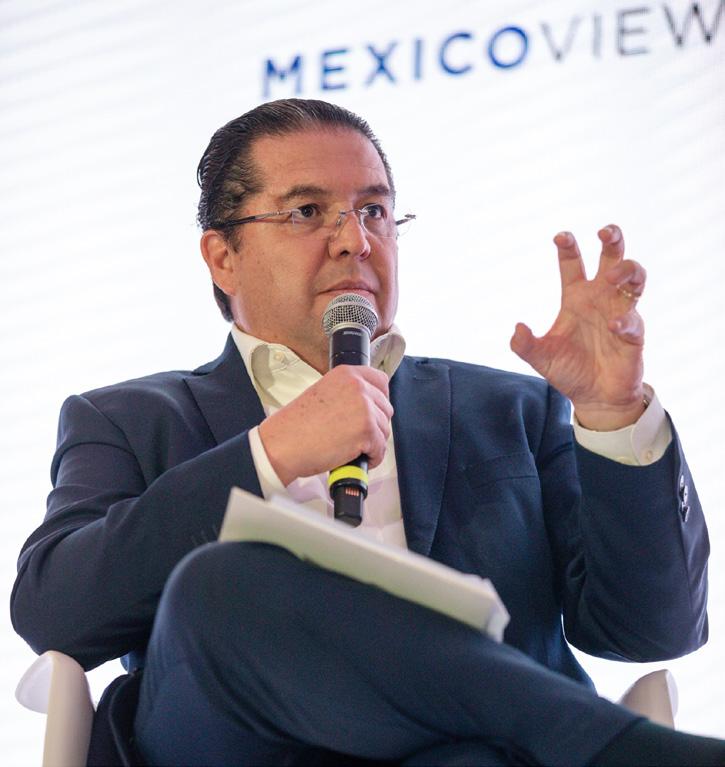



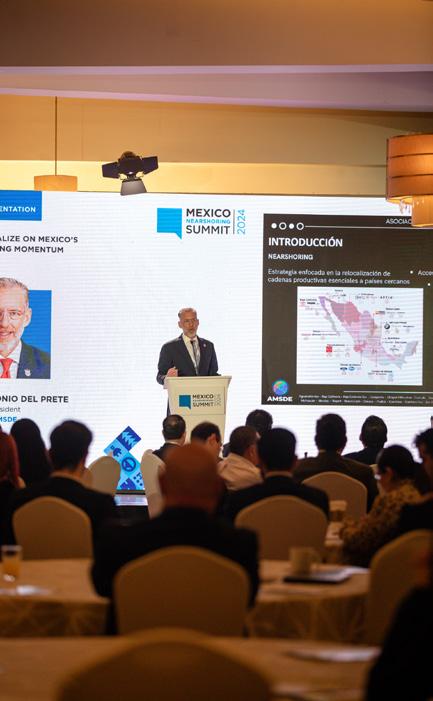

Co NFERENCE H IGHLIGHTS 38
www.mexicobusiness.mx







































